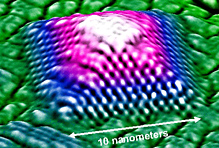Nanoscience and Technology
The NanoTeach focuses on the STEM content area of Nanoscale Science and Nanotechnology (NS&T) and draws upon instructional materials that align with The Big Ideas in Nanoscience. Because it is a new field, the teaching of nanoscience requires the identification of learning goals and the alignment of these goals with national standards and the major concepts sequenced for 7th-12th grade science students. The National Center for Learning and Teaching of Nanoscience (NCLT) and SRI International convened workshops that assembled leading experts in nanoscience, the learning sciences, and science education to identify and articulate the “Big Ideas” of the field. The outcome of these workshops is the document The Big Ideas in Nanoscience. These Big Ideas convey the knowledge and skills that are vital for student competency of this content area. The Big Ideas are: size & scale, structure of matter, size-dependent properties, forces and interaction, self-assembly, tools & instrumentation, models & simulations, science technology and society, and quantum effects.
 |
 |
||
| Georgia Tech professor and student examine a composite fiber made of carbon nanotubes. Courtesy: National Science Foundation | Self assembled Germanium 'pyramid' on Silicon. Courtesy: National Science Foundation. |
NanoTeach will focus on the following Big Ideas and Learning Goals:
Size and Scale
• In order to know the size of an object, it is necessary to be able to compare it to a reference point.
• An object’s surface area-to-volume ratio depends on its size and shape.
Size Dependent Properties
• The surface area-to-volume ratio increases as objects become smaller. As a result, as the size (length scale) of an object approaches the nanoscale, the fraction of the atoms on the surface increases dramatically, and surface–related properties become more important.
• Some of the properties of matter change with size, particularly as the length scale of the sample decreases and approaches the nanoscale.
Forces and Interactions
• Electrical forces are necessary for explaining a broad range of macroscopic phenomena. Students should be able to apply their knowledge to explain these.
• Small objects (e.g., atoms molecules, nanoparticles) can interact in a variety of ways, all of which are electrical in nature. A continuum of electrical forces describes
Tools and Instrumentation
• Specialized tools are required to detect, measure, and investigate the nanoscale world because structures on this scale are too small to be seen with optical microscopes.

